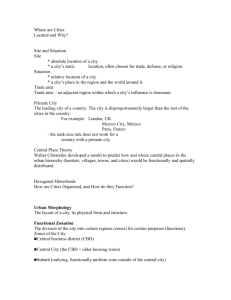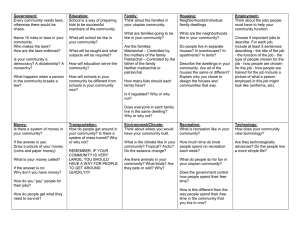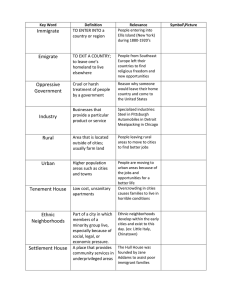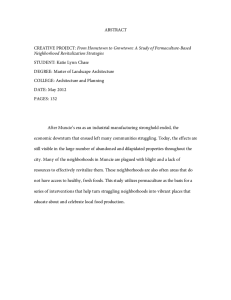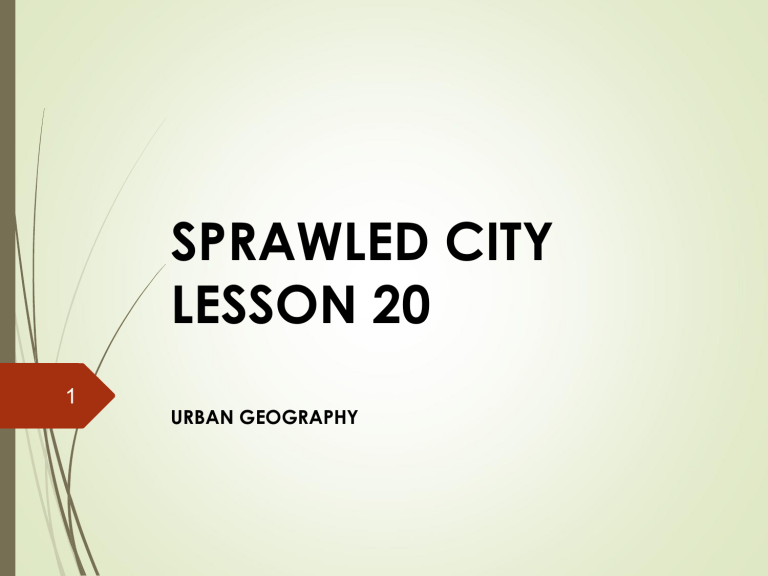
SPRAWLED CITY LESSON 20 1 URBAN GEOGRAPHY 2 Archaeologists have found that the houses in Indus River cities, such as Mohenjo-Daro and Harappa, were a uniform size: each house had access to a sewer system, and palaces were absent from the cultural landscape. Derive a theory as to why these conditions were present in these cities that had both a leadership class and a surplus of agricultural goods. KEY QUESTION: 3 Where are Cities Located and Why? Site and Situation 4 Site Situation * absolute location of a city * relative location of a city * a city’s static location, often chosen for trade, defense, or religion. * a city’s place in the region and the world around it. RANK-SIZE RULE: 5 in a model urban hierarchy, the population of the city or town will be inversely proportional to its rank in the hierarchy. For example: largest city = 12 million 2nd largest = 6 million 3rd largest = 4 million 4th largest = 3 million 6 PRIMATE CITY The leading city of a country. The city is disproportionately larger than the rest of the cities in the country. For example: London, UK Mexico City, Mexico Paris, France * the rank-size rule does not work for a country with a primate city 7 CENTRAL PLACE THEORY WALTER CHRISTALLER developed a model to predict how and where central places in the urban hierarchy (hamlets, villages, towns, and cities) would be functionally and spatially distributed. Assumed: surface is flat with no physical barriers soil fertility is the same everywhere population and purchasing power are evenly distributed region has uniform transportation network from any given place, a good or service could be sold in all directions out to a certain distance KEY QUESTION: 8 How are cities organized, and how do they function? 9 Urban Morphology The layout of a city, its physical form an structure. Berlin, Germany With wall (above) And without wall (right) What does the urban morphology of the city tell us about the city? 10 Powerful social and cultural forces shape the character of a city and create the cultural landscape of the city. Global Periphery and Semiperiphery - Sharp Contrast Between Rich And Poor - Often Lack Zoning Laws Or Enforcement Of Zoning Laws 11 12 Making Cities in the Global Core Redlining – financial institutions refusing to lend money in certain neighborhoods. Blockbusting – realtors purposefully sell a home at a low price to an African American and then solicit white residents to sell their homes and low prices, to generate “white flight.” Making Cities In The Global Core 13 Gentrification – individuals buy up and rehabilitate houses, raising the housing value in the neighborhood and changing the neighborhood. Commercialization – city governments transform a central city to attract residents and tourists. The newly commercialized downtowns often are a stark contrast to the rest of the central city. Tear-downs – houses that new owners buy with the 14 intention of tearing it down to build a much larger home. McMansions – large homes, often built to the outer limits of the lot. They are called McMansions because of their super size and their similar look. Hinsdale, Illinois (25% of houses have been torn down in last 20 years). URBAN SPRAWL 15 Unrestricted growth of housing, commercial developments , and roads over large expanses of land, with little concern for urban planning. Henderson, Nevada 16 New Urbanism Development, urban revitalization, and suburban reforms that create walkable neighborhoods with a diversity of housing and jobs. some are concerned over privatization of public spaces some are concerned that they do nothing to bread down the social conditions that create social ills of the cities some believe they work against urban sprawl GATED COMMUNITIES Who are gated communities for? How do the goals/purposes of gated communities differ across the world? 17 18 ETHNIC NEIGHBORHOODS European City eg. Muslim neighborhoods in Paris Cities of the Periphery and Semiperiphery eg. Mumbai, India MUMBAI, INDIA 19 20 Using the city you sketched in the last “Thinking Geographically” question, consider the concepts and processes introduced in this section of the chapter and explain how people and institutions created this city and the model you sketched. KEY QUESTION: WHAT ROLE DO CITIES PLAY IN GLOBALIZATION? 21 World Cities 22 Cities that function at the global scale, beyond the reach of the state borders, functioning as the service centers of the world economy. 23 SPACES OF CONSUMPTION The transformation of the city into an entertainment district, where major corporations encourage the consumption of their goods and services. For example: Berlin, Germany New York City 24 TIMES SQUARE, NEW YORK CITY 25 Thinking through the challenges to the state presented in Chapter 8, predict whether and under what circumstances world cities could replace states as the basic and most powerful form of political organization in the world.

